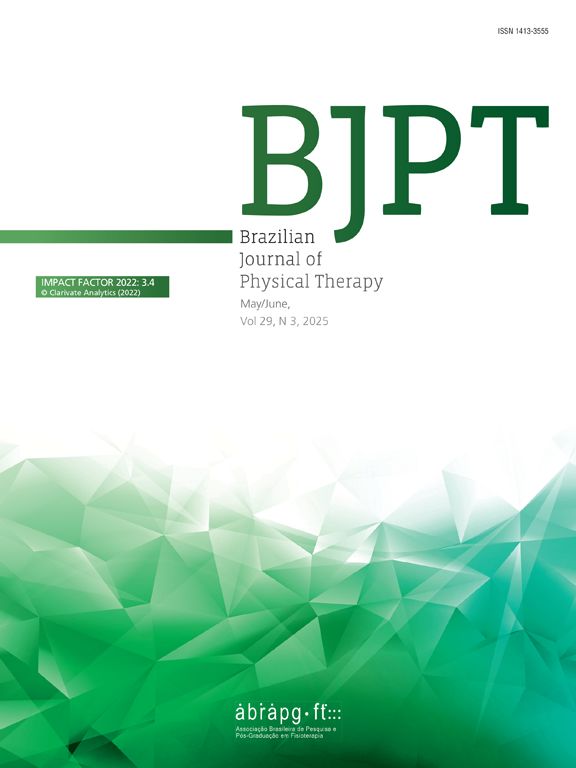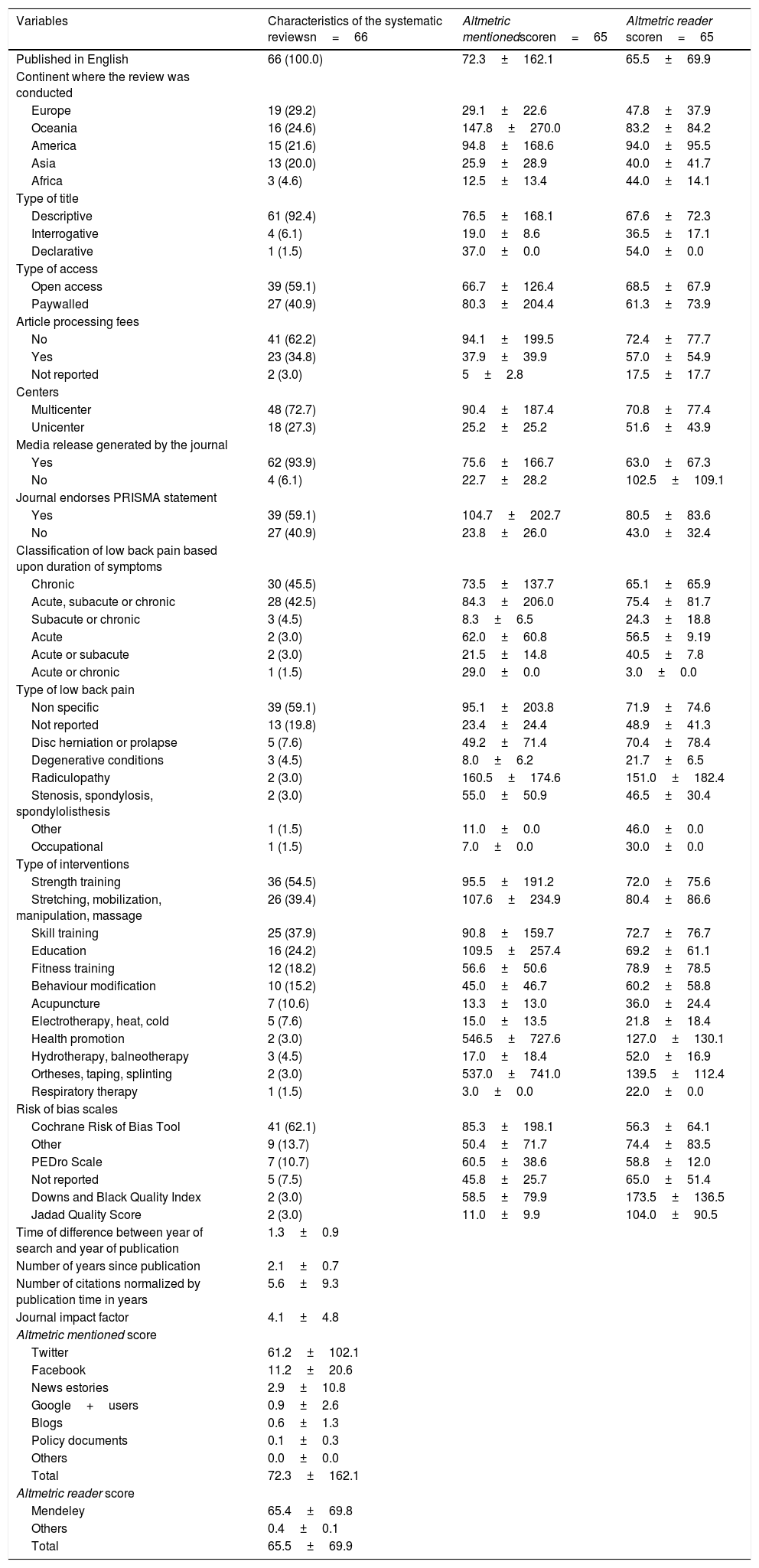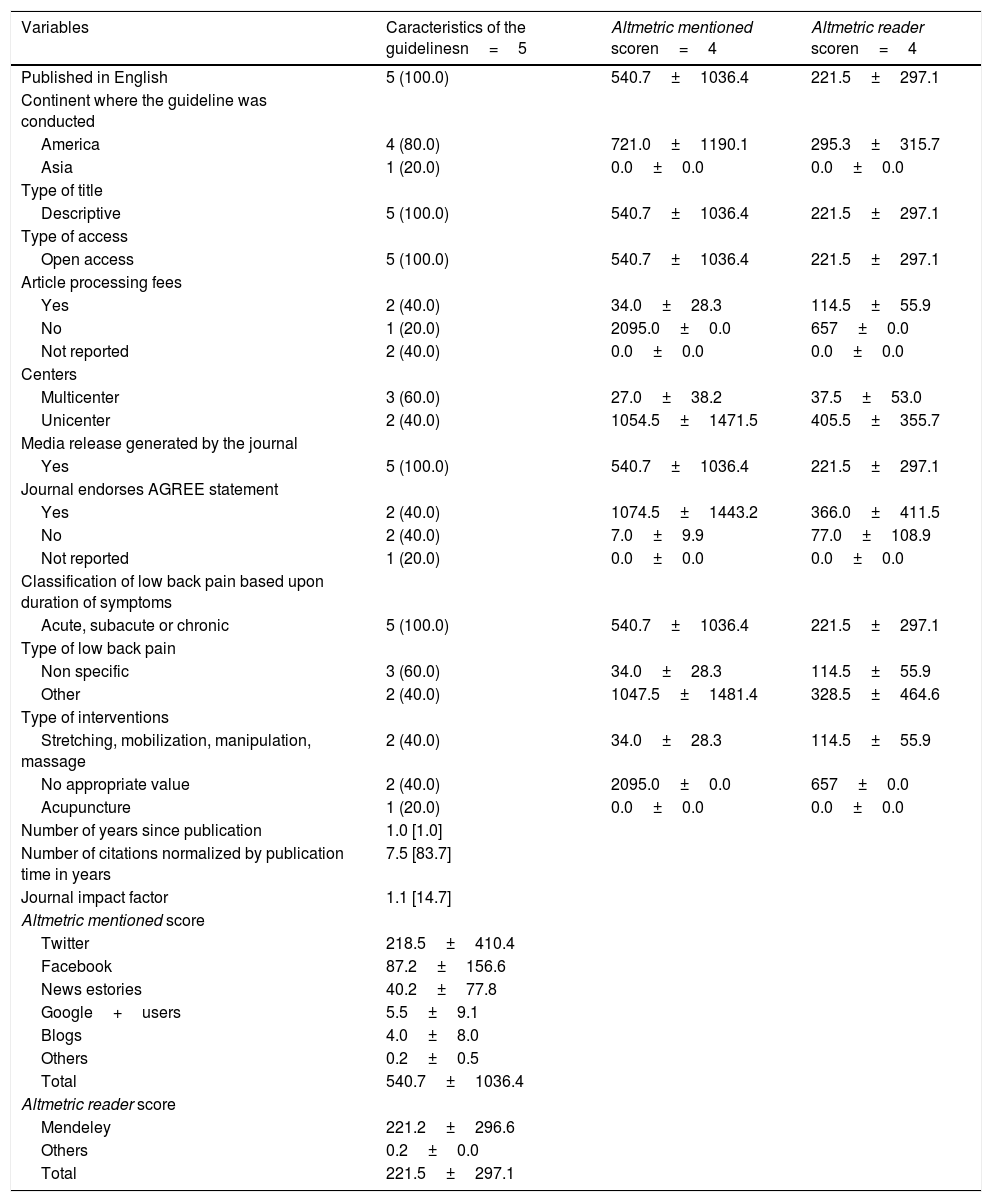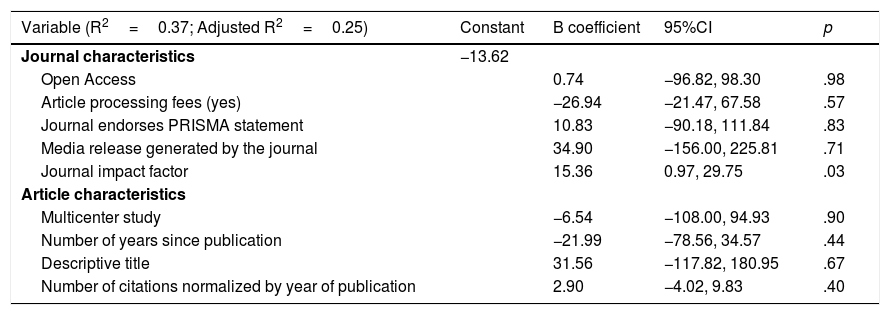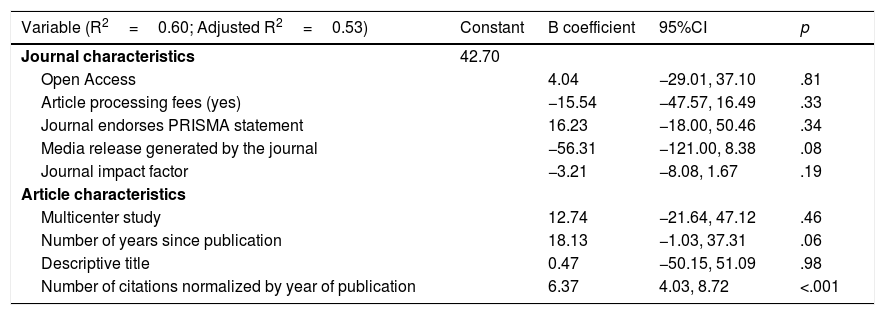Although Altmetric has been widely used by researchers to monitor the audience of their articles, there are no studies that have analysed factors associated with Altmetric score for systematic reviews and clinical practice guidelines.
Objectives1) To analyse factors that could be associated with Altmetric scores for low back pain systematic reviews and clinical practice guidelines. 2) To describe the characteristics of these articles and their Altmetric scores.
MethodsWe searched for all low back pain systematic reviews and guidelines indexed on the Physiotherapy Evidence Database published between 2015 and 2017. We extracted data related to the published paper, the publishing journal, and Altmetric scores.
ResultsA total of 66 systematic reviews and 5 guidelines were included. The variable impact factor (independent variable) was associated with Altmetric mentioned score (dependent variable) with a β coefficient of 15.4 (95% CI: 0.97, 29.7) ajusted to all remaining variables. The variable number of citations normalized by year of publication (independent variable) was associated with Altmetric reader score (dependent variable) with a β coefficient of 6.4 (95% CI: 4.03, 8.72) ajusted to all remaining variables. We also found that the majority of the systematic reviews and guidelines were published in English, had a descriptive title, were published as open access, included multicenter studies, and had media release generated by the publishing journal.
ConclusionMetrics related to the number of citations, such as the impact factor are associated with Altmetric scores.
Evidence-based practice is widely known as a decision-making process that involves not only the best scientific evidence but also clinical expertise and patient preferences.1,2 The use of the best evidence induces the utilization of effective treatments.1,2 Therefore, it is important that key messages from high quality research be widely delivered to clinicians, patients, and policy makers. Unfortunately, this does not always occur1 as many clinicians still find difficulties in locating the best available evidence.3,4 To overcome this issue, many authors and publishers are now sharing the results of their studies on the internet to reach and increase their target readership.5,6 Currently, the use of social media is probably the most effective strategy to increase visibility of scientific articles. Accordingly, a new score named Altmetric was created to measure the attention publications attract online.7
The Altmetric score is composed of two independent scoring systems, the Altmetric mentioned and the Altmetric reader.8 The Altmetric mentioned score is calculated by the number of mentions on social media (e.g. Facebook, Twitter); mainstream media coverage; encyclopaedias (e.g. Wikipedia); online platforms (e.g. Faculty1000 and Publication Peer-Reviews); videos (e.g. YouTube); sites on questions and answers (e.g. Q&A stack overflow); and documents (e.g. policy documents). Each of these mentions receive different weights to calculate a total score (e.g. each mention on Facebook counts 0.25 points while a mention on Twitter counts 1.0 point).8 The Altmetric reader score is calculated by number of mentions by reference managers such as Mendeley, Connotea and CiteULike. Each of these mentions receives identical weights for all reference managers (i.e. 1.0 point for each mention).
To date, there is one systematic review9 and a few original research articles10–13 demonstrating that number of citations and Altmetric scores are positively correlated (with correlation coefficients ranging between r=0.30 and 0.61). In addition, Araujo et al.14 found that, in low back pain clinical trials, the number of citations and the journal’s impact factor were positively associated with Altmetric (with β coefficients of 5.2 and 3.4 points, respectively).14 These results mean that for every citation received, the Altmetric score is likely to be 5.2 points higher. Similarly, for every point of journal’s impact factor the Altmetric score is likely to be 3.4 points higher.14 However, there are no studies that have identified the Altmetric scores or factors associated with the Altmetric score for systematic reviews and clinical practice guidelines. The investigation on factors associated with Altmetric scores could bring new insights for authors and journal editors on how to better disseminate research findings to clinicians using the internet.1
The primary objective of this study was to explore potential factors associated with the publishing journal and the published articles that could be associated with Altmetric scores for low back pain systematic reviews and clinical practice guidelines. The secondary objective of this study was to identify the main characteristics of these articles (impact factor, number of citations normalized by year of publication, language, type of title, type of access, number of centers contributing to the manuscript, and media release generated by the journal). In this study, systematic reviews and clinical practice guidelines for physical therapy interventions for low back pain were chosen by the authors because low back pain has the largest amount of evidence in the field of musculoskeletal health.15 Additionally, low back pain is extremely prevalent16–19 and involves high costs.19–22
MethodsStudy designThis is a cross-sectional study. This manuscript was reported following the recommendations of the STROBE statement.23
Study selectionWe selected all systematic reviews and clinical practice guidelines in the field of low back pain indexed on the Physiotherapy Evidence Database (PEDro - www.pedro.org.au). We chose PEDro because this is the most comprehensive database of clinical trials, systematic reviews, and clinical practice guidelines in the field of physical therapy.24–26 On 01/08/2018 we identified all systematic reviews and clinical practice guidelines in low back pain indexed on PEDro, published between 2015 and 2017 and written in English, Spanish, or Portuguese. We decided to collect data published over a two year period to get a representative sample. Altmetric was launched in 2011. We decided to collect data from a sample starting in 2015 to get the most updated data as possible from Altmetric. We excluded all systematic reviews and clinical practice guidelines not related to low back pain and those with mixed populations. The two search strategies using PEDro advanced search option are described below:
- -
Strategy search: “2015 until 2017” [year of publication] and lumbar spine, sacroiliac joint or pelvis [part of body] and pain [problem] and “systematic reviews” [method].
- -
Strategy search: 2015 until 2017″ [year of publication] and lumbar spine, sacroiliac joint or pelvis [part of body] and pain [problem] and “practice guideline” [method].
The following data were extracted:
- -
Downloaded from PEDro database: full title, authors’ names, journal name, language of publication, year of publication, and type of intervention.
- -
Extracted from the full-text article: continent where the study was conducted, number of research centers, type of low back pain reported by the authors (e.g non specific, disc herniation or prolapse, degenerative conditions, radiculopathy, stenosis, spondylosis, spondylolisthesis or not reported), duration of symptoms, the risk of bias scale used by the article, time difference between year of search and year of publication, type of title categorized as declarative (title expressing the results of the review/guideline), interrogative (title introducing the review/guideline in the form of a question), or descriptive (title describing the aim of the study, but does not reveal the main conclusions).
- -
Extracted from Web of Science: 2017 journal’s impact factor and number of citations.
- -
Extracted from journal web-site: if the journal endorses either the Preferred Reporting Items for Systematic Reviews and Meta-Analyses (PRISMA)27 or Appraisal of Guidelines for Research & Evaluation (AGREE),28 if the paper was published as open access, if journal charges article processing fees, and if the journal produces its own media release (yes/no) (for example, if the journals have their own pages on Facebook, Twitter, Blogs, etc).
- -
Extracted scores from Altmetric web-site: total and individual scores of Altmetric mentions (individual scores (weights) from Facebook (0.25 points), Twitter (1.0 point), Google+user (1.0 point), News Outlet (8.0 points), Blogs (5.0 points), Sina Weibo (1.0 point), Reddit (0.25 points), Linkedin (1.0 point), Highlight Platform (1.0 point), Pinterest (0.25 points), Wikipedia Page (3.0 points), Faculty1000 (1.0 point), Publication Peer-Reviews (1.0 point), YouTube (0.25 points), Q&A (stack overflow)(0.25 points) and Policy Documents (3.0 points). We also collected total and individual scores related to Altmetric reader (individual scores from Mendeley (1.0 point), CiteULike (1.0 point) and Connotea (1.0 point)).
Data related to Altmetric scores and number of citations divided by years since publication were collected on the same day for all articles because these scores are extremely dynamic.
Statistical analysisThe number of years since publication of the article was calculated with 2018 minus year of publication. The number of citations was normalized by the number of years since publication (number of citations divided by years since publication) as it is expected that older manuscripts are more likely to have a larger number of citations compared to newer ones. Descriptive statistics were used to present most of the data.
For the systematic reviews data, multivariable regression models were built to measure the associations of a range of variables with both (i) Altmetric mentioned score and (ii) Altmetric reader score. The independent variables in both models were: open access (yes/no), article processing fees (yes/no), if journal endorses PRISMA statement (yes/no), if journal produces its own media release (yes/no), if the study have descriptive title (yes/no), journal impact factor, multicenter study (yes/no), number of years since publication, and number of citations normalized by year of publication. These variables were chosen as they seem plausible to be associated with Altmetric scores based upon a previous study.14
Multivariable regression models were then built including all potential variables that were likely to predict the Altmetric score. The results were expressed as R² (explained variability of the model) and the individual contribution of each variable through the presentation of Beta coefficients and their respective 95% confidence intervals. We used the Statistical Package for Social Sciences version 20 for the analyses. As the number of clinical practice guidelines was low, it was not possible to built a multivariable regression model.
ResultsSelection of eligible systematic reviewsA total of 7526 reviews were retrieved in PEDro database. From those, 126 reviews were considered as potentially eligible and were fully assessed. A total of 66 reviews fulfilled the inclusion criteria and were included.
Selection of eligible clinical practice guidelinesA total of 181 clinical practice guidelines were retrieved in PEDro database. From those, 7 clinical practice guidelines were considered as potentially eligible and were fully assessed. A total of 5 clinical practice guidelines fulfilled the inclusion criteria and were included.
Descriptive characteristics of the systematic reviewsTable 1 presents the characteristics of the systematic reviews. From the 66 reviews, 65 have an Altmetric score with a mean mentions score of 72.3 points (SD=162.1) and a mean reader score of 65.5 points (SD=69.9). All sytematic reviews were published in English, 92.4% had descriptive titles, 59.1% were published as open access, 72.7% included multicenter studies, and 93.9% had media release generated by the journal. In addition, the mean impact factor of the journals publishing these trials was 4.1 (SD=4.8) with a mean number of citations normalized by year of publication of 5.6 (SD=9.3).
Characteristics of the systematic reviews, Altmetric mentioned and Altmetric reader scores.
| Variables | Characteristics of the systematic reviewsn=66 | Altmetric mentionedscoren=65 | Altmetric reader scoren=65 |
|---|---|---|---|
| Published in English | 66 (100.0) | 72.3±162.1 | 65.5±69.9 |
| Continent where the review was conducted | |||
| Europe | 19 (29.2) | 29.1±22.6 | 47.8±37.9 |
| Oceania | 16 (24.6) | 147.8±270.0 | 83.2±84.2 |
| America | 15 (21.6) | 94.8±168.6 | 94.0±95.5 |
| Asia | 13 (20.0) | 25.9±28.9 | 40.0±41.7 |
| Africa | 3 (4.6) | 12.5±13.4 | 44.0±14.1 |
| Type of title | |||
| Descriptive | 61 (92.4) | 76.5±168.1 | 67.6±72.3 |
| Interrogative | 4 (6.1) | 19.0±8.6 | 36.5±17.1 |
| Declarative | 1 (1.5) | 37.0±0.0 | 54.0±0.0 |
| Type of access | |||
| Open access | 39 (59.1) | 66.7±126.4 | 68.5±67.9 |
| Paywalled | 27 (40.9) | 80.3±204.4 | 61.3±73.9 |
| Article processing fees | |||
| No | 41 (62.2) | 94.1±199.5 | 72.4±77.7 |
| Yes | 23 (34.8) | 37.9±39.9 | 57.0±54.9 |
| Not reported | 2 (3.0) | 5±2.8 | 17.5±17.7 |
| Centers | |||
| Multicenter | 48 (72.7) | 90.4±187.4 | 70.8±77.4 |
| Unicenter | 18 (27.3) | 25.2±25.2 | 51.6±43.9 |
| Media release generated by the journal | |||
| Yes | 62 (93.9) | 75.6±166.7 | 63.0±67.3 |
| No | 4 (6.1) | 22.7±28.2 | 102.5±109.1 |
| Journal endorses PRISMA statement | |||
| Yes | 39 (59.1) | 104.7±202.7 | 80.5±83.6 |
| No | 27 (40.9) | 23.8±26.0 | 43.0±32.4 |
| Classification of low back pain based upon duration of symptoms | |||
| Chronic | 30 (45.5) | 73.5±137.7 | 65.1±65.9 |
| Acute, subacute or chronic | 28 (42.5) | 84.3±206.0 | 75.4±81.7 |
| Subacute or chronic | 3 (4.5) | 8.3±6.5 | 24.3±18.8 |
| Acute | 2 (3.0) | 62.0±60.8 | 56.5±9.19 |
| Acute or subacute | 2 (3.0) | 21.5±14.8 | 40.5±7.8 |
| Acute or chronic | 1 (1.5) | 29.0±0.0 | 3.0±0.0 |
| Type of low back pain | |||
| Non specific | 39 (59.1) | 95.1±203.8 | 71.9±74.6 |
| Not reported | 13 (19.8) | 23.4±24.4 | 48.9±41.3 |
| Disc herniation or prolapse | 5 (7.6) | 49.2±71.4 | 70.4±78.4 |
| Degenerative conditions | 3 (4.5) | 8.0±6.2 | 21.7±6.5 |
| Radiculopathy | 2 (3.0) | 160.5±174.6 | 151.0±182.4 |
| Stenosis, spondylosis, spondylolisthesis | 2 (3.0) | 55.0±50.9 | 46.5±30.4 |
| Other | 1 (1.5) | 11.0±0.0 | 46.0±0.0 |
| Occupational | 1 (1.5) | 7.0±0.0 | 30.0±0.0 |
| Type of interventions | |||
| Strength training | 36 (54.5) | 95.5±191.2 | 72.0±75.6 |
| Stretching, mobilization, manipulation, massage | 26 (39.4) | 107.6±234.9 | 80.4±86.6 |
| Skill training | 25 (37.9) | 90.8±159.7 | 72.7±76.7 |
| Education | 16 (24.2) | 109.5±257.4 | 69.2±61.1 |
| Fitness training | 12 (18.2) | 56.6±50.6 | 78.9±78.5 |
| Behaviour modification | 10 (15.2) | 45.0±46.7 | 60.2±58.8 |
| Acupuncture | 7 (10.6) | 13.3±13.0 | 36.0±24.4 |
| Electrotherapy, heat, cold | 5 (7.6) | 15.0±13.5 | 21.8±18.4 |
| Health promotion | 2 (3.0) | 546.5±727.6 | 127.0±130.1 |
| Hydrotherapy, balneotherapy | 3 (4.5) | 17.0±18.4 | 52.0±16.9 |
| Ortheses, taping, splinting | 2 (3.0) | 537.0±741.0 | 139.5±112.4 |
| Respiratory therapy | 1 (1.5) | 3.0±0.0 | 22.0±0.0 |
| Risk of bias scales | |||
| Cochrane Risk of Bias Tool | 41 (62.1) | 85.3±198.1 | 56.3±64.1 |
| Other | 9 (13.7) | 50.4±71.7 | 74.4±83.5 |
| PEDro Scale | 7 (10.7) | 60.5±38.6 | 58.8±12.0 |
| Not reported | 5 (7.5) | 45.8±25.7 | 65.0±51.4 |
| Downs and Black Quality Index | 2 (3.0) | 58.5±79.9 | 173.5±136.5 |
| Jadad Quality Score | 2 (3.0) | 11.0±9.9 | 104.0±90.5 |
| Time of difference between year of search and year of publication | 1.3±0.9 | ||
| Number of years since publication | 2.1±0.7 | ||
| Number of citations normalized by publication time in years | 5.6±9.3 | ||
| Journal impact factor | 4.1±4.8 | ||
| Altmetric mentioned score | |||
| 61.2±102.1 | |||
| 11.2±20.6 | |||
| News estories | 2.9±10.8 | ||
| Google+users | 0.9±2.6 | ||
| Blogs | 0.6±1.3 | ||
| Policy documents | 0.1±0.3 | ||
| Others | 0.0±0.0 | ||
| Total | 72.3±162.1 | ||
| Altmetric reader score | |||
| Mendeley | 65.4±69.8 | ||
| Others | 0.4±0.1 | ||
| Total | 65.5±69.9 |
Categorical data were expressed as number (percentage). Normal continuous data were expressed as mean ± standard deviation. Standardized citations: number of citations divided by the number of years since publication. The variable other dysfunctions related to disc degeneration, bulging discs, facet joint dysfunction, sacroiliac joint pain, osteoporosis at the lumbar, vertebral fracture, radicular and nonradicular low back pain. PEDro: Physiotherapy Evidence Database. The variable others related to Altmetric mentioned: weibo posts, pins, peer reviews, linkedin posts, faculty 1000 posts, Q&A posts and sillaby. The variable others related to Altmetric reader: CiteUlike and Connotea.
Table 2 presents the characteristics of the clinical practice guidelines. From the 5 articles, 4 have an Altmetric score with a mean mentioned score of 540.7 points (SD=1036.4) and a mean reader score of 221.5 points (SD=297.1). All clinical practice guidelines were published in English, had descriptive titles and were published as open access, 60% included multicenter studies, and 100% had media release generated by the journal. In addition, the mean impact factor of the journals publishing these clinical practice guidelines was 1.1 (SD=14.7) with the mean number of citations normalized by year of publication of 7.5 (SD=83.7).
Characteristics of the clinical practice guidelines, Altmetric mentioned and Altmetric reader scores.
| Variables | Caracteristics of the guidelinesn=5 | Altmetric mentioned scoren=4 | Altmetric reader scoren=4 |
|---|---|---|---|
| Published in English | 5 (100.0) | 540.7±1036.4 | 221.5±297.1 |
| Continent where the guideline was conducted | |||
| America | 4 (80.0) | 721.0±1190.1 | 295.3±315.7 |
| Asia | 1 (20.0) | 0.0±0.0 | 0.0±0.0 |
| Type of title | |||
| Descriptive | 5 (100.0) | 540.7±1036.4 | 221.5±297.1 |
| Type of access | |||
| Open access | 5 (100.0) | 540.7±1036.4 | 221.5±297.1 |
| Article processing fees | |||
| Yes | 2 (40.0) | 34.0±28.3 | 114.5±55.9 |
| No | 1 (20.0) | 2095.0±0.0 | 657±0.0 |
| Not reported | 2 (40.0) | 0.0±0.0 | 0.0±0.0 |
| Centers | |||
| Multicenter | 3 (60.0) | 27.0±38.2 | 37.5±53.0 |
| Unicenter | 2 (40.0) | 1054.5±1471.5 | 405.5±355.7 |
| Media release generated by the journal | |||
| Yes | 5 (100.0) | 540.7±1036.4 | 221.5±297.1 |
| Journal endorses AGREE statement | |||
| Yes | 2 (40.0) | 1074.5±1443.2 | 366.0±411.5 |
| No | 2 (40.0) | 7.0±9.9 | 77.0±108.9 |
| Not reported | 1 (20.0) | 0.0±0.0 | 0.0±0.0 |
| Classification of low back pain based upon duration of symptoms | |||
| Acute, subacute or chronic | 5 (100.0) | 540.7±1036.4 | 221.5±297.1 |
| Type of low back pain | |||
| Non specific | 3 (60.0) | 34.0±28.3 | 114.5±55.9 |
| Other | 2 (40.0) | 1047.5±1481.4 | 328.5±464.6 |
| Type of interventions | |||
| Stretching, mobilization, manipulation, massage | 2 (40.0) | 34.0±28.3 | 114.5±55.9 |
| No appropriate value | 2 (40.0) | 2095.0±0.0 | 657±0.0 |
| Acupuncture | 1 (20.0) | 0.0±0.0 | 0.0±0.0 |
| Number of years since publication | 1.0 [1.0] | ||
| Number of citations normalized by publication time in years | 7.5 [83.7] | ||
| Journal impact factor | 1.1 [14.7] | ||
| Altmetric mentioned score | |||
| 218.5±410.4 | |||
| 87.2±156.6 | |||
| News estories | 40.2±77.8 | ||
| Google+users | 5.5±9.1 | ||
| Blogs | 4.0±8.0 | ||
| Others | 0.2±0.5 | ||
| Total | 540.7±1036.4 | ||
| Altmetric reader score | |||
| Mendeley | 221.2±296.6 | ||
| Others | 0.2±0.0 | ||
| Total | 221.5±297.1 |
Categorical data were expressed as number (percentage). Normal continuous data were expressed as mean ± standard deviation. Non-normal continuous data were expressed as median [interquartile range]. Standardized citations: number of citations divided by the number of years since publication. The variable other dysfunctions related radicular and nonradicular low back pain. The variable others related to Altmetric mentioned: weibo posts, pins, peer reviews, linkedin posts, faculty 1000 posts, Q&A posts and sillaby. The variable others related to Altmetric reader: CiteUlike and Connotea.
The variable impact factor was associated with Altmetric mentioned score with a β coefficient of 15.4 (95% CI 0.97, 29.7) ajusted to all remaining variables (Table 3). These variables accounted for 37% of the explained variance (adjusted R2=0.25). This means that for every one point for the journal’s impact factor, once adjusted for counfounders, the Altmetric mentioned score is likely to be 15.4 points higher.14
Multivariate model to predict characteristics of systematic reviews that were associated with Altmetric mentioned score.
| Variable (R2=0.37; Adjusted R2=0.25) | Constant | B coefficient | 95%CI | p |
|---|---|---|---|---|
| Journal characteristics | −13.62 | |||
| Open Access | 0.74 | −96.82, 98.30 | .98 | |
| Article processing fees (yes) | −26.94 | −21.47, 67.58 | .57 | |
| Journal endorses PRISMA statement | 10.83 | −90.18, 111.84 | .83 | |
| Media release generated by the journal | 34.90 | −156.00, 225.81 | .71 | |
| Journal impact factor | 15.36 | 0.97, 29.75 | .03 | |
| Article characteristics | ||||
| Multicenter study | −6.54 | −108.00, 94.93 | .90 | |
| Number of years since publication | −21.99 | −78.56, 34.57 | .44 | |
| Descriptive title | 31.56 | −117.82, 180.95 | .67 | |
| Number of citations normalized by year of publication | 2.90 | −4.02, 9.83 | .40 |
The variable number of citations normalized by year of publication was associated with Altmetric reader score with a β coefficient of 6.4 (95% CI 4.03, 8.72) adjusted to all remaining variables (Table 4). These variables accounted for 60% of the explained variance (adjusted R2=0.53). This means that for every citation normalized by year of publication, once adjusted for counfounders, the Altmetric reader score is likely to be 6.4 points higher.14
Multivariate model to predict characteristics of systematic reviews that were associated with Altmetric reader score.
| Variable (R2=0.60; Adjusted R2=0.53) | Constant | B coefficient | 95%CI | p |
|---|---|---|---|---|
| Journal characteristics | 42.70 | |||
| Open Access | 4.04 | −29.01, 37.10 | .81 | |
| Article processing fees (yes) | −15.54 | −47.57, 16.49 | .33 | |
| Journal endorses PRISMA statement | 16.23 | −18.00, 50.46 | .34 | |
| Media release generated by the journal | −56.31 | −121.00, 8.38 | .08 | |
| Journal impact factor | −3.21 | −8.08, 1.67 | .19 | |
| Article characteristics | ||||
| Multicenter study | 12.74 | −21.64, 47.12 | .46 | |
| Number of years since publication | 18.13 | −1.03, 37.31 | .06 | |
| Descriptive title | 0.47 | −50.15, 51.09 | .98 | |
| Number of citations normalized by year of publication | 6.37 | 4.03, 8.72 | <.001 |
The primary objective of our study was to analyse potential factors associated with Altmetric scores for low back pain systematic reviews and clinical practice guidelines. The secondary objective of this study was to identify the main characteristics of these scientific articles and their Altmetric scores. We found that systematic reviews published in a journal with a higher impact factor were associated with a higher Altmetric mentioned score. In addition, we observed that the number of times systematic reviews were cited was associated with a higher Altmetric reader score. Finally, we found that most systematic reviews and clinical practice guidelines were published in English, had a descriptive title, were published as open access, were multicenter studies, and had media release generated by the journal.
There are previous articles that have measured correlations between the number of citations and Altmetric scores.9,10,29 These articles concluded that there is a positive correlation between number of citations and Altmetric scores.9,10,29 In addition, Araujo et al.14 found an association between low back pain randomized controlled trials and Altmetric scores. The main result was that number of citations was positively associated with Altmetric mentioned and reader score (β coefficient=5.2 and 10.1 points, respectively).14 These results are very similar with number of citations and Altmetric reader score in our study (β coefficient=5.6 points). Futhermore, Araujo et al.14 found a positive association between journal’s impact factor and Altmetric mentioned score (β coefficient=3.4 points). Similarly, we also found association with journal’s impact factor and Altmetric mentioned score (β coefficient=20.2 points). These associations between the variables number of citations and journal’s impact factor with Altmetric scores can be explained since the impact factor is a measure of the frequency with which the “average article” in a journal has been cited in a particular year or period. The annual impact factor is a ratio between citations and recent citable items published. Thus, the impact factor of a journal is calculated by dividing the number of current year citations to the source items published in that journal during the previous two years.30
We observed that most systematic reviews and clinical practice guidelines had a descriptive title. However, Araujo et al.14 found that descriptive titles have negative association with Altmetric score in randomized controlled trials. Because of the large number of studies using descriptive titles our dataset was unable to discriminate this variable in the multivariable regression model. In addition, we found that the majority of articles were published as open access and had media release generated by the journal. These characteristics increase the likelihood of the article to be more accessed, read, and discussed. In addition, these articles are more likely to be mentioned online (such as in blogs, social media, etc).14
The major strength of this study is the use of a representative (i.e. 100%) sample of all systematic reviews and clinical practice guidelines indexed on PEDro and categorized as “low back pain”. However, a possible limitation of this study is about to external validity as our articles represents only the effects of physical therapy interventions for patients with low back pain. It would be important to replicate our study in other areas to confirm our findings.
ConclusionWhenever possible, researchers should preferrably publish their articles in journals with high impact factor (which is indirectly linked to citations). This aspect increases the visibility of the articles and consequently, their impact. New studies using different research areas to externally validate our findings are needed.
Conflicts of interestThe authors declare no conflicts of interest.

